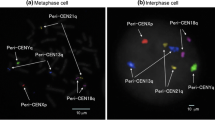Abstract
We describe a FISH protocol that allows rehybridization of complex DNA probes up to four times to the same specimen. This strategy, which we termed ReFISH, opens a wide range of new applications to conventional band pass filter epifluorescence microscopy. These include M-FISH karyotyping and cross-species color banding that emulate multiplex probe sets labeled with up to 12 fluorochromes in sequential hybridizations to the same specimen. We designed a human 24-color karyotyping probe set in combination with a 29-color cross-species color banding probe set using gibbon painting probes. Applying the ReFISH principle, 53 painting probes on individual metaphases were discriminated. This allowed simultaneous screening for inter- and intrachromosomal rearrangements on normal human diploid cells, a HeLa derived cell line, and highly rearranged gibbon chromosomes. Furthermore, the present ReFISH experiments successfully combine 24-color FISH with laser scanning confocal microscopy to study the 3D organization of all 46 human chromosome territories in individual interphase cell nuclei.
Similar content being viewed by others
References
Chudoba I, Plesch A, Lorch T, Lemke J, Claussen U, Senger G (1999) High resolution multicolor-banding: a new technique for recned FISHanalysis of human chromosomes. Cytogenet Cell Genet 84: 156–160.
Epstein L, DeVries S, Waldman FM (1995) Reutilization of previously hybridized slides for fluorescence in situ hybridization. Cytometry 21: 378–381.
Ferguson-Smith MA (1997) Genetic analysis by chromosome sorting and painting: phylogenetic and diagnostic applications. Eur J Hum Genet 5: 253–265.
Henegariu O, Heerema NA, Bray-Ward P, Ward DC (1999) Colour-changing karyotyping: an alternative to M-FISH/SKY. Nat Genet 23: 263–264.
Heslop-Harrison JS, Harrison GE, Leitch IJ (1992) Reprobing of DNA: DNA in situ hybridization preparations. Trends Genet 11: 372–373.
Jauch A, Wienberg J, Stanyon R et al. (1992) Reconstruction of genomic rearrangements in great apes and gibbons by chromosome painting. Proc Natl Acad Sci USA 89: 8611–8615.
Koehler U, Arnold N, Wienberg J, Tofanelli S, Stanyon R (1995a) Genomic reorganization and disrupted chromosomal synteny in the siamang (Hylobates syndactylus) revealed by Luorescence in situ hybridization. Am J Phys Anthropol 97: 37–47.
Koehler U, Bigoni F, Wienberg J, Stanyon R (1995b) Genomic reorganization in the concolor gibbon (Hylobates concolor) revealed by chromosome painting. Genomics 30: 287–292.
Lavappa KS (1978) Survey of ATCC stocks of human cell lines for HeLa contamination. In Vitro 14: 469–475.
Luke S, Shepelsky M (1998) FISH: recent advances and diagnostic aspects. Cell Vis 5: 49–53.
Macville M, Schröck, E, Padilla-Nash H et al. (1999) Comprehensive and decnitive molecular cytogenetic characterization of HeLa cells by spectral karyotyping. Cancer Res 59: 141–150.
Müller S, Wienberg J (2001) 'Bar-coding’ primate chromosomes: molecular cytogenetic screening for the ancestral hominoid karyotype. Hum Genet 109: 85–94.
Müller S, Rocchi M, Ferguson-Smith MA, Wienberg J (1997) Toward a multicolor chromosome bar code for the entire human karyotype by Luorescence in situ hybridization. Hum Genet 100: 271–278.
Müller S, O'Brien PC, Ferguson-Smith MA, Wienberg J (1998) Cross-species colour segmenting: a novel tool in human karyotype analysis. Cytometry 33: 445–452.
Nie W, Rens W, Wang J, Yang F (2001) Conserved chromosome segments in Hylobates hoolock revealed by human and H. leucogenys paint probes. Cytogenet Cell Genet 92: 248–253.
Raap AK (1998) Advances in Luorescence in situ hybridization. Mutat Res 400: 287–298.
Ried T, Baldini A, Rand TC, Ward DC (1992) Simultaneous visualization of seven different DNA probes by in situ hybridization using combinatorial Luorescence and digital imagingmicroscopy. Proc Natl Acad Sci USA 89: 1388–1392.
Ried T, Schröck E, Ning Y, Wienberg J (1998) Chromosome painting: a useful art. Hum Mol Genet 7: 1619–1626.
Roberts I, Wienberg J, Nacheva E, Grace C, Griffin D, Coleman N (1999) Novel method for the production of multiple colour chromosome paints for use in karyotyping by Luorescence in situ hybridisation. Genes Chromosomes Cancer 25: 241–250.
Saracoglu K, Brown J, Kearney L et al. (2001) New concepts to improve resolution and sensitivity of molecular cytogenetic diagnostics by multicolor fluorescence in situ hybridization. Cytometry 44: 7–15.
Schröck E, du Manoir S, Veldman T et al. (1996) Multicolor spectral karyotyping of human chromosomes [see comments]. Science 273: 494–497.
Solovei I, Walter J, Cremer M, Habermann F, Schermelleh L, Cremer, T (2002) FISH on three-dimensionally preserved nuclei. In: Squire J, Beatty B, Mai S (eds) FISH:A Practical Approach. Oxford: Oxford University Press (in press).
Spathas DH, Divane A, Maniatis GM, Ferguson-Smith ME, Ferguson-Smith MA (1994) Prenatal detection of trisomy 21 in uncultured amniocytes by fluorescence in situ hybridization: a prospective study. Prenat Diagn 14: 1049–1054.
Speicher MR, Gwyn Ballard S, Ward DC (1996) Karyotyping human chromosomes by combinatorial multi-fluor FISH. Nat Genet 12: 368–375.
Tanke HJ, Wiegant J, van Gijlswijk RP et al. (1999) New strategy for multi-colour fluorescence in situ hybridisation: COBRA: COmbined Binary RAtio labelling. Eur J Hum Genet 7: 2–11.
Telenius H, Pelmear AHP, Tunnacliffe A et al. (1992) Cytogenetic analysis by chromosome painting using DOP-PCR ampliced Low-sorted chromosomes. Genes Chromosomes Cancer 4: 257–263.
Wang MR, Perissel B, Malet P (1995) Rehybridization on metaphases studied previously by FISH. An approach to analyze chromosome aberrations. Cancer Genet Cytogenet 85: 58–60.
Ye CJ, Lu W, Liu G et al. (2001) The combination of SKY and specicc loci detection with FISH or immunostaining. Cytogenet Cell Genet 93: 195–202.
Yu D, Yang F, Liu R (1997) [A comparative chromosome map between human and Hylobates hoolock built by chromosome painting.] Yi Chuan Xue Bao 24: 417–423.
Zhen DK, Wang JY, Falco VM, Weber W, Delli-Bovi L, Bianchi DW (1998) Poly-FISH: a technique of repeated hybridizations that improves cytogenetic analysis of fetal cells in maternal blood. Prenat Diagn 18: 1181–1185.
Author information
Authors and Affiliations
Rights and permissions
About this article
Cite this article
Müller, S., Neusser, M. & Wienberg, J. Towards unlimited colors for fluorescence in-situ hybridization (FISH) . Chromosome Res 10, 223–232 (2002). https://doi.org/10.1023/A:1015296122470
Issue Date:
DOI: https://doi.org/10.1023/A:1015296122470




